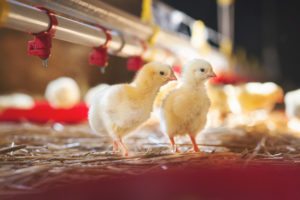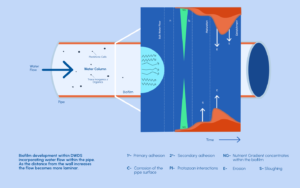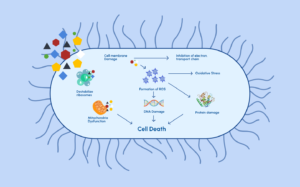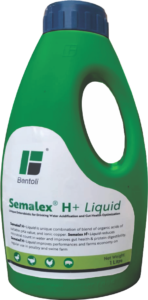Good quality water is extremely necessary for better intestinal health and to establish a healthy gut flora, which will facilitate the birds to absorb all the essential nutrients. During the entire lifetime, a five-pound broiler will consume about 18 pounds of water, compared to approximately 10 pounds of feed (Lacy, 2002). Due to rapid growth in the poultry sector,people have switched to semiautomatic and automation lines of water supply to their poultry flock.If the proper hygiene is not maintained in the water line there may be a high chance of biofilm formation.
What is biofilm?
Biofilms are defined as a group of bacterial cells attached in the surface of biotic or abiotic things and link with each other and produce the extracellular matrix layer (López et al., 2010). These matrix layers are sticky in nature and are made up of extracellular polymeric substances (EPSs). These matrix layers protect the microorganisms from environmental stresses like physical (pH, temperature) and chemical (disinfectants & antibiotics) substances. Biofilm formation in the poultry industry followed by pathogenic microorganisms grown in the water surfaces and attached to the abiotic surfaces like pipelines and storage tanks produces the biofilm layer and contaminates the water. Contaminated water causes numerous bacterial infections in livestock and the results are severe economic losses in the poultry industry.
Biofilm formation can be controlled by the following method:
(i) Minimalizing the concentration of organic matter entering the distribution system;
(ii) Prevention of water stagnation and sediment build-up within the distribution chain
(iii) Keep a sufficient disinfectant level throughout the distribution chain.
Chemical disinfection
The main approach to control biofilm accumulation is chemical disinfection, particularly with chlorine, and an increase in its residual concentration through the network. Yet, this has to be done carefully; high chlorine concentrations can cause organoleptic problems,an increase in the production of carcinogenic, namely trihalomethanes and haloacetic acids, which are harmful and lead to the selection of resistant microorganisms (Mj et al., 2000).
Oligodynamics- the newer approach to reinforce water acidification !
Oligodynamic is the ability of minerals to exert a lethal effect on bacterial cells. Oligodynamic metals, such as copper and silver, have long been used as sanitizers for non-spore-forming bacteria and viruses (Thurman & Gerba 1988).Copper has been used as a biocide for centuries (Dollwet et al., 2001).
Water acidifiers, while powered by ionic copper, offer a broad spectrum of effects on water borne infectants. The best part of the oligodynamic mechanism is the broader spectrum of coverage whether it is gram positive and gram negative as well.
Dror-Ehre et al.(2010) stated a pre-emptive and promising strategy which control the biofilm with an aqueous suspension of silver nanoparticles as a pre-treatment in water systems prior to the main water treatment units, such as membrane filtration. This technique is not meant as a treatment for the eradication of existing or mature biofilms or as a disinfection process. The pre-treatment with molecularly-capped silver nanoparticles presented in this study was able to control or retard biofilm development on pipe surfaces.
Bentoli’s innovative solution, Semalex® H+ liquid is a unique enterobiotic for drinking water acidification and gut health optimization. It is a superior combination of short chain fatty acids, and ionic copper offering water acidification and gut eubiosis.
The efficacy of Semalex® H+ Liquid was checked on to inhibition of biofilm formation by Escherichia coli, Salmonella enterica subsp. indica and Pseudomonas aeruginosa were evaluated using the microplate titer method using dosages ranging from 0 to 1000 ppm. A competitor product was evaluated along with Semalex H+ Liquid.
The study revealed that biofilm formation by S. enterica subsp. indica and P. aeruginosa were inhibited at the lowest tested dosage level of 100 ppm of Semalex® H+ Liquid , whereas biofilm inhibition by E. coli was observed from 200 ppm onwards. In contrast, the competitor product inhibited all three bacterial cultures only above 400 ppm dosage level. The usage of Semalex® H+ Liquid in the water supply pipe lines should prevent biofilm formation and inhibit the growth of pathogenic organisms.
Reference:
Dollwet HHA, Sorenson JRJ. Historic uses of copper compounds in medicine. Trace Elements Med 2001; 2: 80-7.
Dror-Ehre, A., Adin, A., Markovich, G. and Mamane, H., 2010. Control of biofilm formation in water using molecularly capped silver nanoparticles. Water research, 44(8), pp.2601-2609.
Lacy M. P. Broiler management. In : Commercial Chicken Meat and Egg Production (D.B. Bell and W.D. Weaver, Eds.) 5th Ed. 2002. P. 829–868.
López D, Vlamakis H, Kolter, R. (2010). “Biofilms”. Cold Spring Harbor Perspectives in Biology. 2 (7): a000398.
Mj, N., 2000. Toledano MB. Eaton NE. Fawell J. Elliott P. Chlorination disinfection byproducts in water and their association with adverse reproductive outcomes: a review. Occupational & Environmental Medicine, 57(2), pp.73-85.
Thurman, R.B., Gerba, C.P. and Bitton, G., 1989. The molecular mechanisms of copper and silver ion disinfection of bacteria and viruses. Critical reviews in environmental science and technology, 18(4), pp.295-315.





